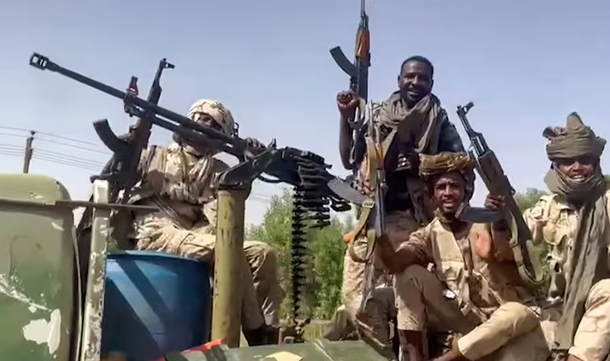Civil War in Sudan: A Detailed Overview (GS Paper 2, IR)

Recent Developments
- As of October 2024, the Sudanese Armed Forces (SAF) have intensified military operations against the Rapid Support Forces (RSF) in Khartoum and Bahri.
- This escalation comes after a period of relative calm in the ongoing civil war that has plagued Sudan for over 18 months.
- The conflict has resulted in catastrophic humanitarian outcomes, including more than 20,000 deaths and nearly 11 million people displaced, highlighting the urgent need for intervention and resolution.
Origins of the Conflict
Power Struggle
- At the heart of the conflict is a power struggle between General Abdel Fattah al-Burhan, the leader of the SAF, and General Hamdan Dagalo (Hemedti), the head of the RSF.
- Their rivalry reflects deeper issues regarding governance and control in Sudan, with both factions vying for dominance over the military and political landscape.
Historical Background
- Colonial Legacy:
- Sudan's modern history is heavily influenced by its colonial past as a joint protectorate of Egypt and Britain.
- This legacy created deep-seated divisions between the wealthier Arab Muslim north and the predominantly Christian and Animist south, laying the groundwork for future conflicts.
- Major Civil Wars:
- Sudan has endured two major civil wars:
- The First Civil War (1955-1972) led to millions of deaths and was primarily fought over cultural and economic disparities.
- The Second Civil War (1983-2005) was characterized by issues of governance, identity, and the struggle for autonomy, culminating in the secession of South Sudan in 2011.
- Bashir's Regime:
- Omar al-Bashir ruled Sudan for 30 years following a coup in 1989. His government was marked by a brutal approach to dissent, using private militias like the Janjaweed against various ethnic groups, particularly in Darfur.
- Bashir's administration faced international condemnation for committing genocide against non-Arab ethnic groups, leading to widespread atrocities and humanitarian crises.
Post-Bashir Transition
Overthrow and Transitional Government
- In April 2019, growing protests against Bashir's oppressive regime culminated in his ousting.
- This was a pivotal moment, as both the SAF and RSF played critical roles in the coup.
- After his removal, Sudan entered a transitional phase, initially involving both military and civilian leaders, which aimed to stabilize the country and guide it toward democratic governance.
RSF’s Emergence
- The RSF was formed from the Janjaweed militias that were instrumental in the Darfur conflict. Officially established in 2013, it became a powerful entity in Sudan, controlling substantial resources, including gold mines.
- The RSF has exploited the chaos to gain economic and military strength, positioning itself as a rival to the SAF.
The December 2022 Agreement
- A significant moment in Sudan's political landscape occurred with the December 2022 agreement, which aimed to transition the country to civilian rule over a two-year period.
- However, tensions arose regarding the integration of the RSF into the national army, highlighting divisions between Burhan and Hemedti.
Reasons for Ongoing Conflict
- Power Struggle:
- Both the SAF and RSF are driven by ambitions to consolidate power. The SAF claims legitimacy as the national military, while the RSF seeks to assert its influence and maintain autonomy, leading to violent confrontations.
- Weapon Supply:
- Despite a UN arms embargo initiated during the Darfur crisis in 2004, weapons continue to flood into Sudan. Advanced military equipment is often supplied by foreign states, particularly Russia, China, and the UAE, exacerbating the conflict.
- Ethnic Tensions:
- The civil war has taken on an ethnic dimension, particularly in regions like Darfur. Arab militias predominantly support the RSF, while non-Arab communities, such as the Masalit, align with the SAF, deepening societal divisions.
- Foreign Interference:
- External actors have provided support to both factions, complicating efforts for peace. This foreign involvement creates a dynamic where local actors are less incentivized to negotiate or compromise.
- Failed Peace Talks:
- Numerous attempts at ceasefires and peace negotiations, including the Jeddah Declaration in 2023, have failed. These efforts, often led by international actors like Saudi Arabia and the US, have not succeeded in creating a lasting resolution, partly due to ongoing hostilities and mistrust.
Humanitarian Impact
The humanitarian situation in Sudan is dire:
- Over 11 million people are displaced, creating one of the largest refugee crises in recent history.
- Access to basic necessities, including food, water, and medical care, has been severely compromised.
- Children and vulnerable populations face heightened risks, including malnutrition, lack of education, and exposure to violence.
Conclusion
- The civil war in Sudan is a complex conflict fueled by historical grievances, power struggles, ethnic tensions, and foreign influences.
- The humanitarian consequences are staggering, with millions suffering from the fallout of this ongoing violence.
- A comprehensive approach that addresses the underlying issues, promotes inclusive dialogue, and involves the international community is essential for a sustainable resolution and rebuilding of Sudan.


